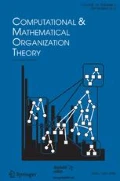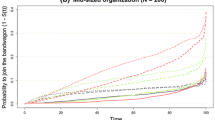Abstract
The emergence of a shared attitude in organizations can be regarded as a self-organizing complex process in which a majority attitude emerges from the ensemble of interactions among individuals. Almost by definition, emerging processes seem beyond the control of management, which is in conflict with the task of management to steer an organization. By modeling the emergence of a shared attitude in organizations, we were able to demonstrate that management had a distinct influence on this process. Furthermore, the first round of interactions was decisive for the outcome. The key to influencing the emergence of a shared attitude is to reduce resistance against the preferred attitude. High levels of group conformity inhibited conversion to the preferred attitude. Although the emergence of a shared attitude can be influenced by management, there remains an intrinsic uncertainty in the outcomes of attitude development processes.



Similar content being viewed by others
References
Ajzen I (1991) The theory of planned behavior. Organ Behav Hum Decis Process 50:179–211
Anderson P (1999) Complexity theory and organization science. Organ Sci 10:216–232
Anderson C, Brown CE (2010) The functions and dysfunctions of hierarchy. In: Brief AP, Staw BM (eds) Research in organizational behavior: an annual series of analytical essays and critical reviews. Research in organizational behavior, vol 30. Elsevier, New York, p 55–89
Bock GW, Zmud RW, Kim YG, Lee JN (2005) Behavioral intention formation in knowledge sharing: examining the roles of extrinsic motivators, social-psychological forces, and organizational climate. MIS Q 29:87–111
Bouckenooghe D (2010) Positioning change recipients’ attitudes toward change in the organizational change literature. J Appl Behav Sci 46:500–531
Brown SL, Eisenhardt KM (1997) The art of continuous change: linking complexity theory and time-paced evolution in relentlessly shifting organizations. ASQ 42:1–34
Burke CS, Stagl KC, Salas E, Pierce L, Kendall D (2006) Understanding team adaptation: a conceptual analysis and model. J Appl Psychol 91:1189–1207
Burnes B (2005) Complexity theories and organizational change. Int J Manag Rev 7:73–90
Burton RM, Obel B, Desanctis G (2011) Organizational Design, a step-by-step approach. Cambridge University Press, Cambridge
Chiles TH, Meyer AD, Hench TJ (2004) Organizational emergence: the origin and transformation of Branson, Missouri’s musical theaters. Organ Sci 15:499–519
Cialdini RB, Goldstein NJ (2004) Social influence: compliance and conformity. Annu Rev Psychol 55:591–621
Compton J, Jackson B, Dimmock JA (2016) Persuading others to avoid persuasion: inoculation theory and resistant health attitudes. Front Psychol. doi:10.3389/fpsyg.2016.00122
Dent EB, Goldberg GS (1999) Challenging “Resistance to Change”. J Appl Behav Sci 35:17
Dutton JE, Dukerich JM (1991) Keeping an eye on the mirror—image and identity in organizational adaptation. Acad Manag J 34:517–554
Eaton AA, Visser PS, Krosnick JA, Anand S (2009) Social power and attitude strength over the life course. Personal Soc Psychol Bull 35:1646–1660
Fernandez S, Rainey HG (2006) Managing successful organizational change in the public sector. Pub Adm Rev 66:168–176
Friedkin NE (2001) Norm formation in social influence networks. Soc Netw 23:167–189
Goldberg LR (1993) The structure of phenotypic personality-traits. Am Psychol 48:26–34
Granovetter M (1978) Threshold models of collective behavior. Am J Sociol 83:1420–1443
Haslam SH (2001) Psychology in organizations. The social identity approach. SAGE Publications, London
Higgs M, Rowland D (2011) What does it take to implement change successfully? A study of the behaviors of successful change leaders. J Appl Behav Sci 47:309–335
Hofstede G, Neuijen B, Ohayv DD, Sanders G (1990) Measuring organizational cultures—a qualitative and quantitative study across 20 cases. Adm Sci Q 35:286–316
Hogg MA, Smith JR (2007) Attitudes in social context: a social identity perspective. Eur Rev Soc Psychol 18:89–131
Hogg MA, Turner JC, Davidson B (1990) Polarized norms and social frames of reference—a test of the self-categorization theory of group polarization. Basic Appl Soc Psychol 11:77–100
Hollander EP (1986) On the central role of leadership processes. Appl Psychol 35:39–52
Jones MR, Karsten H (2008) Giddens’s structuration theory and information systems research. MIS Q 32:127–157
Kauffman SA (1993) The origins of order self organization and selection in evolution, vol xviii. Oxford University Press, New York
Kotter JP (2001) What leaders really do. Harv Bus Rev 79:85
Kotter JP (2007) Leading change—why transformation efforts fail. Harv Bus Rev 85:96–105
Kotter JP, Schlesinger LA (1979) Choosing strategies for change. Harv Bus Rev 57:106–114
Krackhardt D, Hanson JR (1993) Informal networks—the company behind the chart. Harv Bus Rev 71:104–111
Krosnick JA, Boninger DS, Chuang YC, Berent MK, Carnot CG (1993) Attitude strength—one construct or many related constructs. J Personal Soc Psychol 65:1132–1151
Latane B (1981) The psychology of social impact. Am Psychol 36:343–356
Latane B, Wolf S (1981) The social impact of majorities and minorities. Psychol Rev 88:438–453
Lau CM, Woodman RW (1995) Understanding organizational-change—a schematic perspective. Acad Manag J 38:537–554
Lum JL (1970) Interaction patterns of nursing personnel. Nurs Res 19:324–330
Macy MW (1990) Learning-theory and the logic of critical mass. Am Sociol Rev 55:809–826
Marion R, Uhl-Bien M (2001) Leadership in complex organizations. Leadersh Q 12:389–418
Markus H (1977) Self-schemata and processing information about self. J Personal Soc Psychol 35:63–78
Meyer AD (1982) Adapting to environmental jolts. Adm Sci Q 27:515–537
Meyer JP, Stanley DJ, Herscovitch L, Topolnytsky L (2002) Affective, continuance, and normative commitment to the organization: a meta-analysis of antecedents, correlates, and consequences. J Vocat Behav 61:20–52
Meyer AD, Gaba V, Colwell KA (2005) Organizing far from equilibrium: nonlinear change in organizational fields. Organ Sci 16:456–473
Monge P, Heiss BM, Margolin DB (2008) Communication network evolution in organizational communities. Commun Theory 18:449–477
Morel B, Ramanujam R (1999) Through the looking glass of complexity: the dynamics of organizations as adaptive and evolving systems. Organ Sci 10:278–293
Murphy P (1996) Chaos theory as a model for managing issues and crises. Public Relat Rev 22:95–113
Nowak A, Szamrej J, Latane B (1990) From private attitude to public-opinion—a dynamic theory of social impact. Psychol Rev 97:362–376
Olson JM, Zanna MP (1993) Attitudes and attitude-change. Annu Rev Psychol 44:117–154
Oreg S (2003) Resistance to change: developing an individual differences measure. J Appl Psychol 88:680–693
Oreg S (2006) Personality, context, and resistance to organizational change. Eur J Work Organ Psychol 15:73–101
Oreg S, Vakola M, Armenakis A (2011) Change recipients’ reactions to organizational change: a 60-year review of quantitative studies. J Appl Behav Sci 47:461–524
Plowman DA, Solansk S, Beck TE, Baker L, Kulkarni M, Travis DV (2007) The role of leadership in emergent, self-organization. Leadersh Q 18:341–356
Raven BH, French JRP (1958) Legitimate power, coercive power, and observability in social-influence. Sociometry 21:83–97
Robertson PJ, Roberts DR, Porras JI (1993) Dynamics of planned organizational change: assessing empirical support for a theoretical model. Acad Manag J 36:619–634
Rosen MA, Bedwell WL, Wildman JL, Fritzsche BA, Salas E, Burke CS (2011) Managing adaptive performance in teams: guiding principles and behavioral markers for measurement. Hum Resour Manag Rev 21:107–122
Rousseau DM (2011) Reinforcing the micro/macro bridge: organizational thinking and pluralistic vehicles. J Manag 37:429–442
Schelling TC (1971) Dynamic models of segregation. J Math Sociol 1:143–186
Seeger MW (2002) Chaos and crisis: propositions for a general theory of crisis communication. Public Relat Rev 28:329–337
Seeger MW, Ulmer RR, Novak JM, Sellnow T (2005) Post-crisis discourse and organizational change, failure and renewal. J Organ Change Manag 18:78–95
Snyder M, Stukas AA (1999) Interpersonal processes: the interplay of cognitive, motivational, and behavioral activities in social interaction. Annu Rev Psychol 50:273–303
Solinger ON, van Olffen W, Roe RA (2008) Beyond the three-component model of organizational commitment. J Appl Psychol 93:70–83
Tajfel H (1974) Social identity and intergroup behaviour social science. Inf Sur les Sci Soc 13:65–93
Thietart RA, Forgues B (1995) Chaos theory and organization. Organ Sci 6:19–31
Turner JC, Wetherell MS, Hogg MA (1989) Referent informational influence and group polarization. Br J Soc Psychol 28:135–147
Watts DJ (2004) The “new” science of networks. Annu Rev Sociol 30:243–270
Wood W (2000) Attitude change: persuasion and social influence. Annu Rev Psychol 51:539–570
Young M (2009) A meta model of change. J Organ Change Manag 22:524–548
Author information
Authors and Affiliations
Corresponding author
Rights and permissions
About this article
Cite this article
van Woensel, P., de Gilder, D., van den Besselaar, P. et al. Managerial influence on attitude formation in organizations: how to manage emergence. Comput Math Organ Theory 23, 496–523 (2017). https://doi.org/10.1007/s10588-016-9239-8
Published:
Issue Date:
DOI: https://doi.org/10.1007/s10588-016-9239-8




